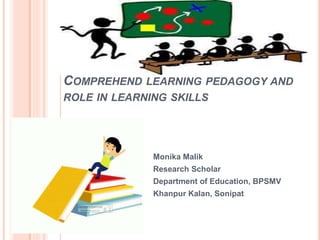
Comprehend learning pedagogy and role in learning skills .pptx
- 1. COMPREHEND LEARNING PEDAGOGY AND ROLE IN LEARNING SKILLS Monika Malik Research Scholar Department of Education, BPSMV Khanpur Kalan, Sonipat
- 2. INTRODUCTION: “The more I live, the more I learn. The more I learn, the more I realize, the less I know.” ― Michel Legrand “Tell me and I forget, teach me and I may remember, involve me and I learn.” — Benjamin Franklin
- 3. PEDAGOGY
- 5. LEARNING Learning is “a process that leads to change, which occurs as a result of experience and increases the potential for improved performance and future learning” (Ambrose et al, 2010, p.3). The change in the learner may happen at the level of knowledge, attitude or behavior.
- 7. LEARNING STYLES- WHAT TYPE OF LEARNER ARE YOU?
- 8. WHO ARE EFFECTIVE LEARNERS? Those who are clear about what they need to learn Actively acquire knowledge and skills Use a range of skills to enhance their ability to lean, retain and recall information and skills
- 9. KNOW YOUR LEARNING STYLE Knowing about our learning style helps us to : Be more productive Increase achievement Be more creative Improve problem solving Make better decisions Learn more effectively
- 10. LEARNING SKILL: Time Management Organizational Skill Critical Thinking Creativity Curiosity Adaptabilty Digital Literacy Critical Thinking Communication Skills Collabration
- 11. WHAT TO LEARN? 1. Skills that are of your interest 2. Skills that are compulsory to learn for social and personal life 3. Skills that are in demand
- 12. Law of readiness. Students learn more easily when they have a desire to learn. Conversely, students learn with difficulty if they're not interested in the topic. Law of effect. Learning will always be much more effective when a feeling of satisfaction, pleasantness, or reward is part of the process. Law of relaxation. Students learn best and remember longest when they are relaxed. Reducing stress increases learning and retention. Law of association. Learning makes sense (comprehension) when the mind compares a new idea with something already known. Law of involvement. Students learn best when they take an active part in what is to be learned. Law of exercise. The more often an act is repeated or information reviewed, the more quickly and more permanently it will become a habit or an easily remembered piece of information. Law of relevance. Effective learning is relevant to the student's life. Law of intensity. A vivid, exciting, enthusiastic, enjoyable learning experience is more likely to be remembered than a boring, unpleasant one. Law of challenge. Students learn best when they're challenged with novelty, a variety of materials, and a range of instructional strategies. Law of feedback. Effective learning takes place when students receive immediate and specific feedback on their performance. Law of recency. Practicing a skill or new concept just before using it will ensure a more effective performance. Law of expectations. Learners' reaction to instruction is shaped by their expectations related to the material (How successful will I be?). Law of emotions. The emotional state (and involvement) of students will shape how well and how much they learn. Law of differences. Students learn in different ways. One size does not fit all! HOW TO LEARN? LAWS OF LEARNING
- 13. TO BE CONTD… Compare. How are these things alike? Classify. Into what groups could you organize these things? Induce. Based on this information, what is the likely conclusion? Deduct. What predictions can you make, or what conclusions can you draw? Analyze errors. How is this information misleading? Construct support. What is an argument that will support this claim? Abstract. What is the general pattern underlying this information? Analyze perspectives. What is the reasoning behind this perspective? Think critically. Be and see accurately. Be open-minded. Think creatively. Push the limits of one's knowledge. Find new ways of looking at a situation. Self-regulate. Be aware of one's own thinking. Evaluate the effectiveness of one's own actions.
- 14. HOW TO APPLY? “Knowledge without application is like a book that is never read” ~Christopher Crawford In his taxonomy, Bloom suggests that application means students take what they’ve learned and apply it to a different scenario, often one outside of the classroom. For example, students could use a math formula they’ve learned to calculate a family budget or apply a legal ruling to a specific case in news headlines.
- 15. TO BE CONTD….. Establish An Action Plan And Review Your Goals Seek Out Experiential Learning Opportunities Get Out In The World And Make Some Mistakes Put What You’ve Been Learning Into Use Support Others In Their Learning
